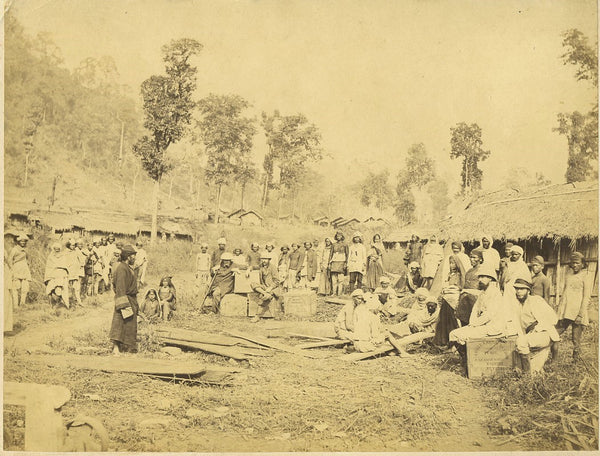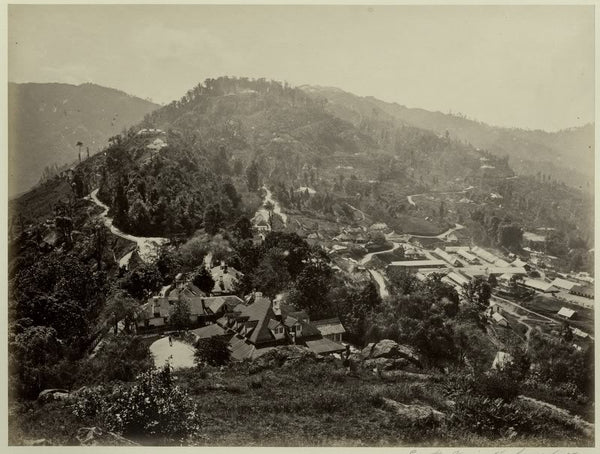
History of Darjeeling Tea - the German Connection ~ Part 3
The Wernicke-Stolke Tea Enterprise continues...
Around the middle of the 19th Century, the British colonialists launched a massive effort to grow tea in India. They desperately wanted to break the Chinese tea monopoly but the Chinese would not comply. Ultimately the British resorted to actually stealing bushes and seeds from China to transplant in India. (That's a whole other story for another day!)

Andrew Wernicke recalled as a boy how the government in Darjeeling eagerly distributed 20 pounds of tea seeds to anyone willing to try to cultivate this greatly desired crop.
That the German missionary families of Wernickes and Stolkes got involved in the fledgling tea industry is no surprise. They did not have much to lose, having been veritably abandoned by their benefactor Rev William Start soon after their arrival in the hills. Proselytizing the highlanders “who spoke so many different languages” was tough, and it appears they dropped their missionary work and started a business - at least the Wernickes did - to fend for themselves.
Around 1866 Andrew and his brother Fred acquired 550 acres of land in Lingia for Rs 600. The government was giving away land for tea gardens at nominal prices. The brothers next took over the neighbouring spur of Tumsong. The latter was 400 acres wide and was a “free gift” from the government. Both the brothers had been managers in tea gardens for a few years and they felt they could take on the challenge of owning some themselves.

However, they continued to work in their former positions even as they took on the arduous task of setting up their own gardens. Andrew still took care of Makaibarie and Tukvar and Fred managed Soom. It would take 5 to 6 years before their new tea gardens could begin production and therefore their income as managers was essential.
Finally, around 1873 both brothers took the plunge. They gave up their manager's posts and moved into Lingia from where they took care of Tumsong as well. It was certainly not easy, but fortune began to smile on these brave men eventually. Five years later a separate factory and manager’s bungalow was built for Tumsong into which Andrew moved in with his family.
Frank Warnick (he anglicized his name for “patriotic” purposes), one of Andrew Wernicke’s sons, records the hardship of early days but which ultimately yielded enormous rewards for the family. “The opening of Lingia and Tumson was a bold and arduous venture for father and Fred, and it was only by exercising the most rigid economy and sacrificing even the simplest of luxuries that they were able to achieve their objective...Their labor and self-denial were amply rewarded later with such success as they could never have dreamt of, so that these sons of poor stranded German missionaries were able to send their own children to England and have then educated at well-known public schools...and enable them to enjoy so many things, which their father and mother had never known or thought possible in those days of their early struggle.”

Lt Col L Hannagan,who worked as a manager for the Wernickes in Bannockburn, writes in Darjeeling Planting - Then and Now: “In 1876, the Wernickes had already discovered that Darjeeling teas possessed something which was very rare in the world of their time, and is by no means common today, and this is the intrinsic flavor of teas grown at high altitudes and in particular aspects. They were also beginning to find out for themselves how elusive flavor in tea can be, and how easily it is lost by damage to leaf in transport over long distances and in stuffy baskets...They were aware of differences in flavor between individual gardens and districts or sub-districts. They were already beginning to recognize the differing flavors by such terms as ‘lemon’, ‘strawberry’, ‘muscatel’, etc., and they knew that a blend of two distinctive flavors produced an unrecognizable and not very desirable bastard.”
"They were aware of differences in flavor between individual gardens and districts or sub-districts. They were already beginning to recognize the differing flavors by such terms as ‘lemon’, ‘strawberry’, ‘muscatel’, etc., and they knew that a blend of two distinctive flavors produced an unrecognizable and not very desirable bastard.”
In other words, the Wernicke brothers were among the first to discover the unique character of Darjeeling tea and refine manufacturing techniques. Their contribution was indeed vital to what the world eventually came to recognize as the “champagne of teas.”

Andrew and Fred’s youngest brother Samuel David had also joined the tea gardens. At one time he was a manager at Singell Tea Estate and one of the owners of Lingia. Sadly, he died from an unknown cause at age 28. Not much is else known about him.
Andrew managed Tumsong (which started as Tamsong - as the locals still pronounce it - until 1884 when the name change name appeared in the Thackers Directory) until 1884 when he was forced to retire due to ill health. Leaving the tea gardens, he took residence in Willow Dale in Darjeeling. While “remotely” supervising the tea business, he also became an active member of the local community as a benefactor to many local organizations.

Interestingly, one of his most memorable contributions to Darjeeling is one that never happened. Andrew had generously offered Rs 50,000 to the Darjeeling Municipality for the Beechwood property when it came up for sale. It was the former residence of the town superintendent, Dr Campbell, with substantial grounds adorned by rhododendrons trees planted by Dr JD Hooker, famous British explorer from the Victorian era. Andrew wanted the property to be secured as a park for public use. Importantly, Beechwood was also the place were Dr Campbell built the first experimental nursery for tea in Darjeeling.

Considered as a “scandal” at the time, the Municipality turned down Andrew’s offer and instead sold the property to another German, C Forstmann, who tore down the place and set up the Rink. The noble Andrew, who died in Darjeeling in January 1904, would be having convulsions in his grave, to see that the Rink has now given way to a monstrous high rise.
Coming back to the Wernicke’s tea business, Tumsong was managed by a series of managers until the third generation of Wernickes took over. Andrew’s eldest son, Ernest A Wernicke in 1895 became manager at Tumsong. He stayed there until 1901 when he moved to Bannockburn which he had bought jointly with his uncle Fred. Ernest returned to Tumsong in 1910 as one of the proprietors.

Ernest’s brother, Fredrick Wernicke, returned from schooling in England, and became assistant manager at Lingia in 1898 at age 21. He later took charge of Pandam tea estate, which by now included the adjoining Alubari tea estate and stayed there right up until 1936 when he retired.
Glenburn tea estate was added to the family tea business in 1895. As an example of how the ownership and management was kept within the family, Thackers Directory notes Glenburn owners as Andrew Wernicke, Fred Wernicke and MM Crawford (husband of Andrew’s eldest daughter, Ethel) and the manager, FA Bruce Cowley (nephew, son of Andrew’s sister, Mary).
Next: The Stolkes
History of Darjeeling Tea - the German Connection ~ Part 1
History of Darjeeling Tea - the German Connection ~ Part 2
History of Darjeeling Tea - the German Connection ~ Part 4

